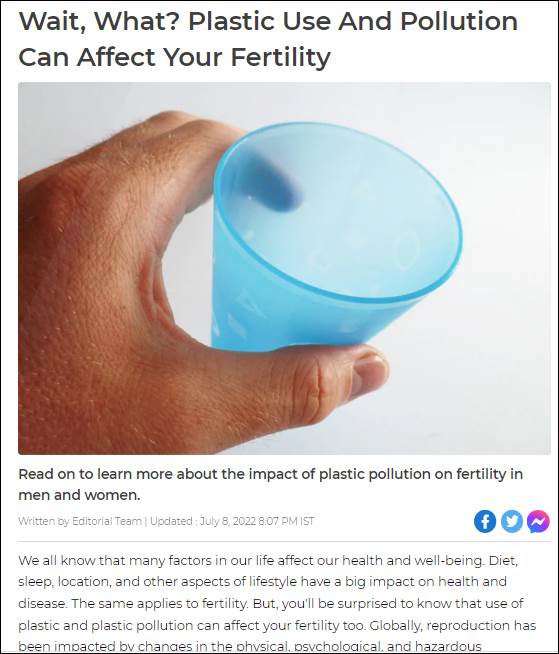Wait, What? Plastic Use And Pollution Can Affect Your Fertility
Author: Dr Vandna Narula, MBBS, DGO, MD (Obs & Gynae)
Consultant: Fertility specialist at Motherhood Fertility and IVF Center – Chandigarh

We all know that many factors in our life affect our health and well-being. Diet, sleep, location, and other aspects of lifestyle have a big impact on health and disease. The same applies to fertility. But, you’ll be surprised to know that use of plastic and plastic pollution can affect your fertility too. Globally, reproduction has been impacted by changes in the physical, psychological, and hazardous environmental variables.
Learn more about impact of plastic pollution on fertility in men and women in this article.
Factors that can have an impact on fertility
Numerous lifestyle choices in both men and women have an impact on fertility. Diet, weight, and exercise; psychological and physical stress; occupational and environmental exposures; and substance use and abuse are a few examples. The endocrine system is one of the most important components of female fertility cycles, and environmental variables like pollution create changes in the design that can show up as disorders like PCOD (Polycystic Ovarian Disease).
How plastic affects fertility?
Plastic products contain EDCs (Endocrine Disrupting Chemicals) compounds in high amount. They are also present in food, water, the environment, the air, and manufactured goods. They have the potential to affect both men’s and women’s reproductive systems as well as the body’s regular operations.
The presence of 800 fake EDCs in commonplace objects like food containers made of plastic, personal care products, and food products is more problematic. EDCs are also used in industrial, agricultural, and manufacturing activities.
It is often hard to ascertain precisely whether and how particular chemicals harm our health since we are exposed to mixtures of so many different types of chemicals. But research has shown that EDCs, which mimic or disrupt sex hormones in both men and women, can have detrimental impacts on reproductive health (estrogen and testosterone). In addition to altering hormone levels, this can result in poorer quality sperm and eggs, DNA damage in sperm, longer menstrual cycles, a longer gestation period, a higher risk of miscarriage, and an earlier menopause. People who are exposed to high concentrations of some EDCs at work are more likely to experience fertility issues. Notably, greater levels of some EDCs reduce the likelihood of conception in couples who use assisted reproductive technology (ART) to conceive.
Is your fertility at risk from environmental pollution?
There are several causes for the environment’s severe contamination; plastic islands are floating in the oceans, and tones of unprocessed waste are dumped into them. In turn, this makes eating seafood risky because one could consume these toxic compounds and end up having problems with fertility.
The chances of a miscarriage are increased by heavy metal exposure like mercury and lead as well as environmental pollutants. As the stress from heat waves increases on the ovaries, thermal stress is another element that is becoming more and more important. Women who spend a lot of time in the sun because of their employment are particularly vulnerable.
What steps must be taken to maintain our fertility levels?
One needs to control their sleep cycle. Because the body undergoes cell regeneration and hormone changes in rhythm while sleeping, sleep is a crucial component of the reproductive process. Additionally, melatonin, a dark hormone produced during sleep that benefits the entire body system.
Despite the uncertainty, there are steps one can take to safeguard their fertility. To maintain general health, practice frequent exercise, keep away from processed foods, maintain a balanced diet, abstain from tobacco and alcohol, talk to your doctor about any negative effects of your medications, and steer clear of endocrine disruptors.
Returning to our origins, whenever possible, avoiding the use of plastic containers for heating meals, switching to eco-friendly household goods comprised of materials like ceramic, bamboo, coconut, and fabric are some of the ways to remain healthy among this crisis.
Conclusion
Although technology has given us access to a more comfortable way of life, we often fail to recognize how negatively it is harming our health. Additionally, it harms our world and results in permanent harm. So, its time to replace plastics with more sustainable and eco-friendly goods around you , better late than never!
The article is contributed by Dr Vandna Narula, Senior consultant – IVF & infertility, Motherhood Fertility & IVF, Chandigarh.


